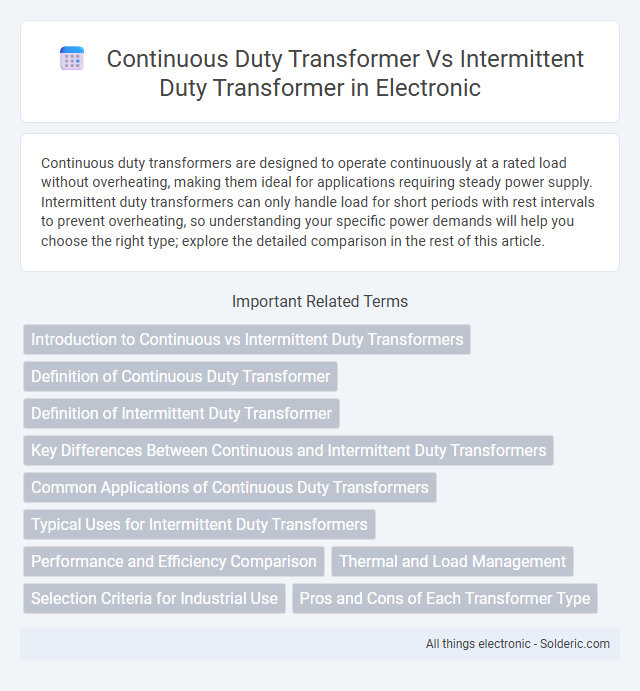Continuous duty transformers are designed to operate continuously at a rated load without overheating, making them ideal for applications requiring steady power supply. Intermittent duty transformers can only handle load for short periods with rest intervals to prevent overheating, so understanding your specific power demands will help you choose the right type; explore the detailed comparison in the rest of this article.
Comparison Table
| Aspect | Continuous Duty Transformer | Intermittent Duty Transformer |
|---|---|---|
| Operation Duration | Designed for continuous, 24/7 operation without overheating | Operates for short periods with rests to prevent overheating |
| Cooling | Enhanced cooling systems to maintain temperature during continuous load | Standard cooling sufficient for short, intermittent loads |
| Design | Robust windings and insulation for sustained thermal stress | Optimized for thermal cycling and intermittent load conditions |
| Applications | Industrial plants, power distribution, continuous processes | Elevators, cranes, intermittent machinery, standby equipment |
| Cost | Higher initial cost due to durable materials and design | Lower cost, less stringent design requirements |
| Efficiency | Optimized for steady load efficiency | Efficient under short-time, variable loads |
Introduction to Continuous vs Intermittent Duty Transformers
Continuous duty transformers are designed to operate consistently under full-rated load without overheating, making them ideal for applications requiring steady power supply over extended periods. Intermittent duty transformers handle short-duration loads with intervals of rest, preventing thermal buildup and optimizing performance for cyclical or varying power demands. Selecting the appropriate transformer type depends on load characteristics, thermal limits, and application-specific operational cycles.
Definition of Continuous Duty Transformer
A continuous duty transformer is designed to operate at full load continuously without overheating or performance degradation, typically rated for 100% duty cycle. These transformers maintain steady voltage regulation and thermal stability under constant electrical loads, making them ideal for applications requiring uninterrupted power supply. Unlike intermittent duty transformers, continuous duty transformers can handle sustained energy transfer without requiring cooldown periods.
Definition of Intermittent Duty Transformer
Intermittent duty transformers are designed to operate for short periods with breaks for cooling, preventing overheating during non-continuous load cycles. These transformers are suitable for applications where power demand is periodic or sporadic, making them less efficient for continuous operation. Their construction prioritizes thermal insulation and cooling intervals to manage temperature rise during brief, high-load periods.
Key Differences Between Continuous and Intermittent Duty Transformers
Continuous duty transformers are designed to operate reliably under a constant load for extended periods, ensuring stable voltage regulation and thermal management. Intermittent duty transformers handle variable or short-term loads with cooling periods in between, making them ideal for applications with fluctuating power demands. The core difference lies in their thermal performance and duty cycle, where continuous duty transformers maintain steady-state operation without overheating, unlike intermittent duty models.
Common Applications of Continuous Duty Transformers
Continuous duty transformers are predominantly used in applications requiring uninterrupted power supply such as industrial machinery, HVAC systems, and lighting installations. These transformers are designed to operate efficiently under constant load without overheating, making them ideal for power distribution in commercial buildings and manufacturing plants. Their robust construction supports long-duration operation, ensuring reliability in critical systems that demand steady voltage regulation.
Typical Uses for Intermittent Duty Transformers
Intermittent duty transformers are ideal for applications where power is needed only for short periods, such as in welding machines, medical equipment, and control circuits of industrial machinery. These transformers handle varying loads without overheating, making them suitable for devices that operate in cycles or require bursts of energy. When selecting a transformer for such purposes, you should consider intermittent duty models to ensure efficient performance and longevity under sporadic use conditions.
Performance and Efficiency Comparison
Continuous duty transformers deliver superior performance and efficiency by maintaining stable operation under constant load conditions, minimizing heat generation and energy losses. Intermittent duty transformers are optimized for short-duration loads with periodic cooling intervals, resulting in lower overall efficiency and reduced thermal stability during prolonged use. The choice between these transformers hinges on load patterns, with continuous duty models offering enhanced reliability and energy savings in applications demanding sustained power delivery.
Thermal and Load Management
Continuous duty transformers are engineered to operate at their rated load continuously without exceeding thermal limits, ensuring effective heat dissipation and stable temperature rise during prolonged use. Intermittent duty transformers tolerate higher short-term loads but require cooling periods to prevent overheating, relying on thermal time constants to manage load cycles effectively. Optimizing thermal management in continuous duty transformers improves efficiency and lifespan, while intermittent duty transformers demand precise load scheduling to maintain operational integrity and prevent insulation degradation.
Selection Criteria for Industrial Use
Continuous duty transformers are ideal for industrial applications requiring constant power supply due to their ability to handle sustained loads without overheating, ensuring reliable performance in processes such as manufacturing and heavy machinery operation. Intermittent duty transformers suit applications with fluctuating or occasional power demands, offering cost efficiency and reduced thermal stress during short-term or cyclical use in equipment like testing devices or standby systems. Selection criteria emphasize load duration, thermal management, and operational continuity to align transformer capabilities with specific industrial requirements.
Pros and Cons of Each Transformer Type
Continuous duty transformers provide steady power output ideal for applications requiring uninterrupted operation, offering superior thermal management and longer lifespan but typically come with higher initial costs and larger size. Intermittent duty transformers are cost-effective and compact, making them suitable for applications with occasional use and lower thermal stress, but frequent operation can lead to overheating and reduced durability. Your choice depends on whether your priority is consistent performance under load or cost savings with occasional use.
continuous duty transformer vs intermittent duty transformer Infographic

 solderic.com
solderic.com